SEO
How Is It Different From GPT-3.5?

GPT-4, the latest version of ChatGPT, OpenAI’s language model, is a breakthrough in artificial intelligence (AI) technology that has revolutionized how we communicate with machines.
ChatGPT’s multimodal capabilities enable it to process text, images, and videos, making it an incredibly versatile tool for marketers, businesses, and individuals alike.
What Is GPT-4?
GPT-4 is 10 times more advanced than its predecessor, GPT-3.5. This enhancement enables the model to better understand context and distinguish nuances, resulting in more accurate and coherent responses.
Furthermore, GPT-4 has a maximum token limit of 32,000 (equivalent to 25,000 words), which is a significant increase from GPT-3.5’s 4,000 tokens (equivalent to 3,125 words).
“We spent 6 months making GPT-4 safer and more aligned. GPT-4 is 82% less likely to respond to requests for disallowed content and 40% more likely to produce factual responses than GPT-3.5 on our internal evaluations.” – OpenAI
GPT-3.5 Vs. GPT-4 – What’s Different?
GPT-4 offers several improvements over its predecessor, some of which include:
1. Linguistic Finesse
While GPT-3.5 is quite capable of generating human-like text, GPT-4 has an even greater ability to understand and generate different dialects and respond to emotions expressed in the text.
For example, GPT-4 can recognize and respond sensitively to a user expressing sadness or frustration, making the interaction feel more personal and genuine.
One of the most impressive aspects of GPT-4 is its ability to work with dialects, which are regional or cultural variations of a language.
Dialects can be extremely difficult for language models to understand, as they often have unique vocabulary, grammar, and pronunciation that may not be present in the standard language.
However, GPT-4 has been specifically designed to overcome these challenges and can accurately generate and interpret text in various dialects.
2. Information Synthesis
GPT-4 can answer complex questions by synthesizing information from multiple sources, whereas GPT-3.5 may struggle to connect the dots.
For example, when asked about the link between the decline of bee populations and the impact on global agriculture, GPT-4 can provide a more comprehensive and nuanced answer, citing different studies and sources.
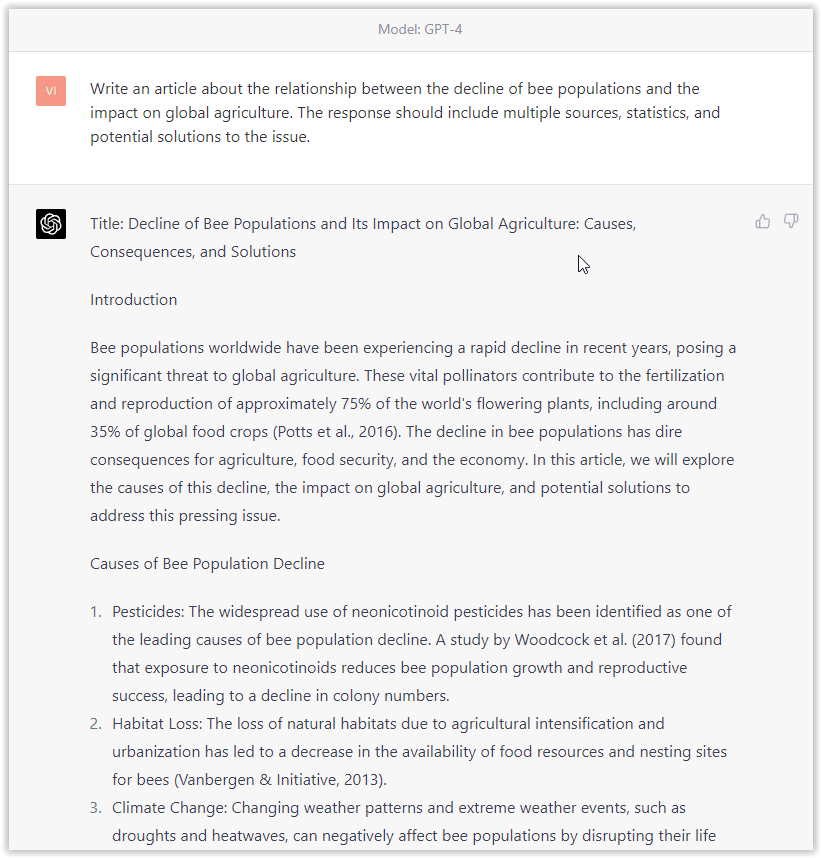 Screenshot from OpenAI, March 2023
Screenshot from OpenAI, March 2023Unlike its predecessor, GPT-4 now includes a feature that allows it to properly cite sources when generating text.
This means that when the model generates content, it cites the sources it has used, making it easier for readers to verify the accuracy of the information presented.
3. Creativity And Coherence
While GPT-3.5 can generate creative content, GPT-4 goes a step further by producing stories, poems, or essays with improved coherence and creativity.
For example, GPT-4 can produce a short story with a well-developed plot and character development, whereas GPT-3.5 might struggle to maintain consistency and coherence in the narrative.
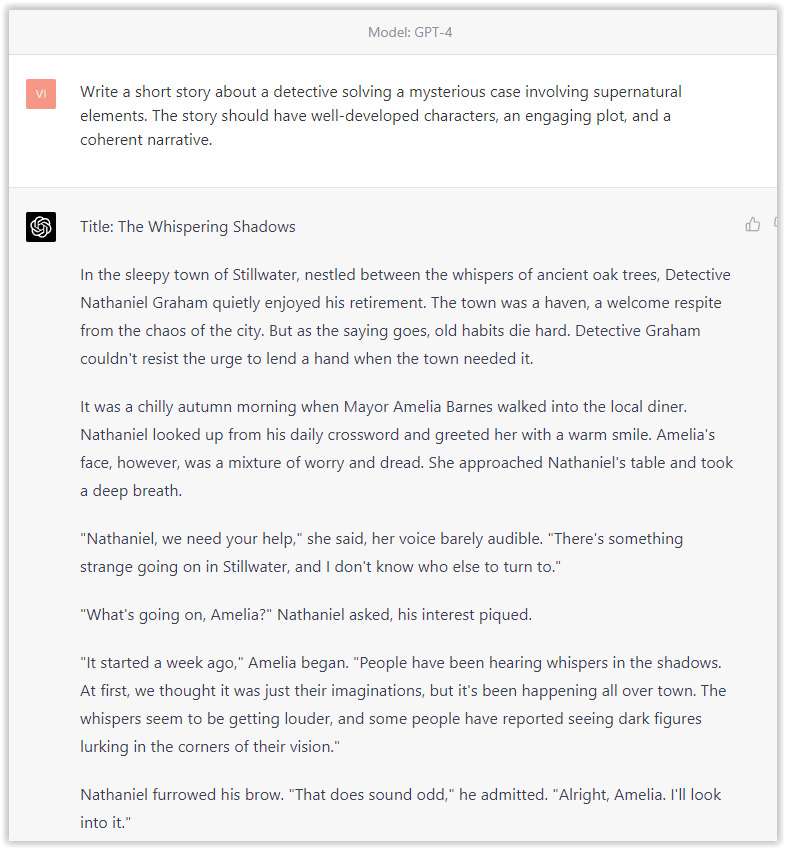 Screenshot from OpenAI, March 2023
Screenshot from OpenAI, March 2023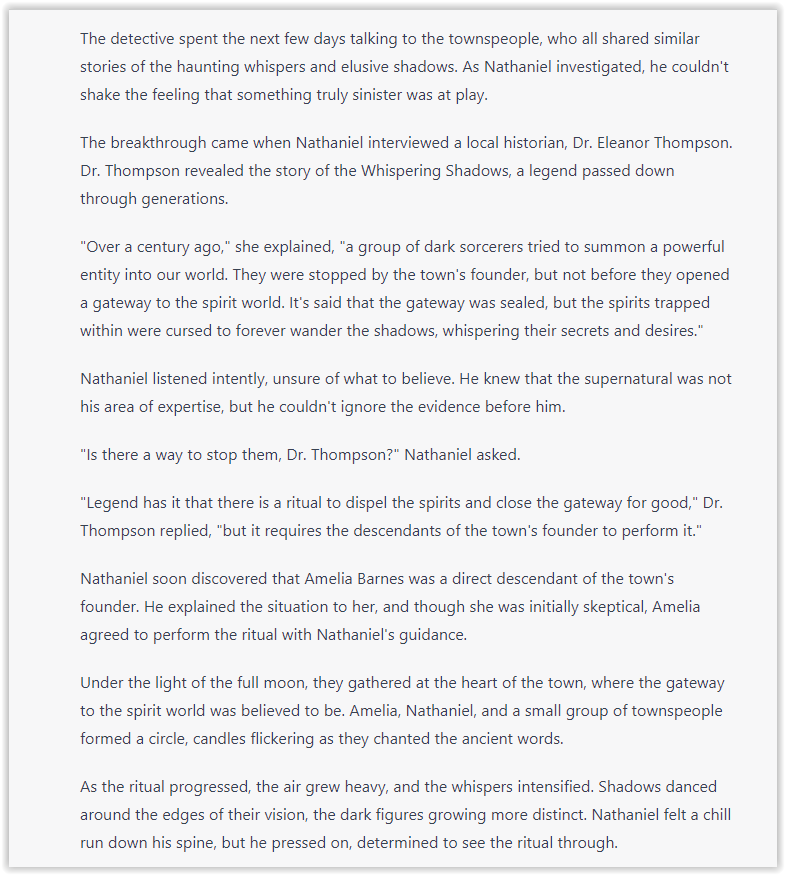 Screenshot from OpenAI, March 2023
Screenshot from OpenAI, March 20234. Complex Problem-Solving
GPT-4 demonstrates a strong ability to solve complex mathematical and scientific problems beyond the capabilities of GPT-3.5.
For example, GPT-4 can solve advanced calculus problems or simulate chemical reactions more effectively than its predecessor.
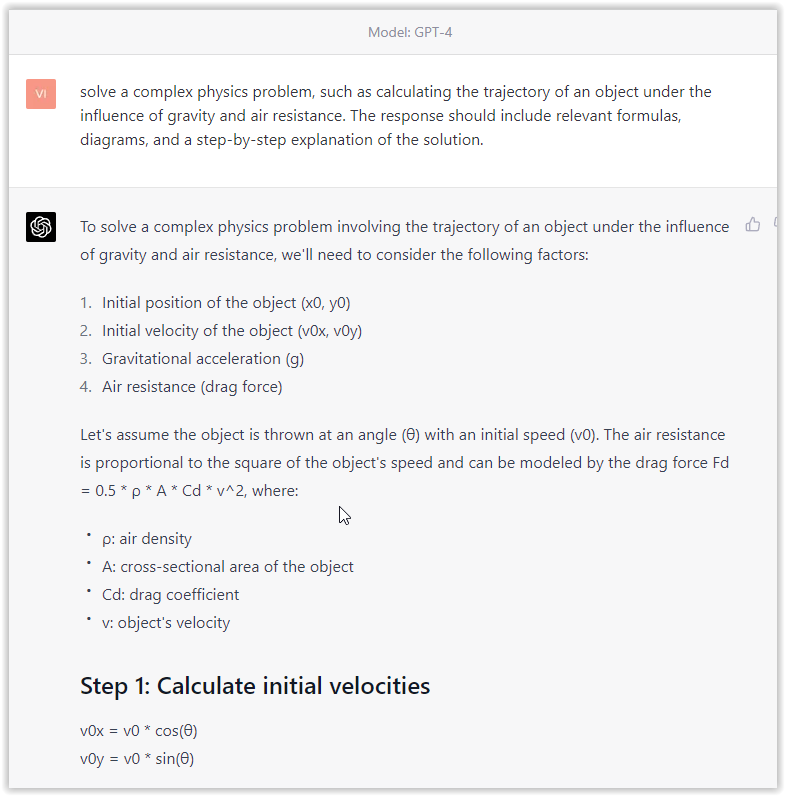 Screenshot from OpenAI, March 2023
Screenshot from OpenAI, March 2023 Screenshot from OpenAI, March 2023
Screenshot from OpenAI, March 2023GPT-4 has significantly improved its ability to understand and process complex mathematical and scientific concepts. Its mathematical skills include the ability to solve complex equations and perform various mathematical operations such as calculus, algebra, and geometry.
In addition, GPT-4 is also capable of handling scientific subjects such as physics, chemistry, biology, and astronomy.
Its advanced processing power and language modeling capabilities allow it to analyze complex scientific texts and provide insights and explanations easily.
As the technology continues to evolve, it is likely that GPT-4 will continue to expand its capabilities and become even more adept at a wider range of subjects and tasks.
5. Programming Power
GPT-4’s programming capabilities have taken social media by storm with its ability to generate code snippets or debug existing code more efficiently than GPT-3.5, making it a valuable resource for software developers.
With the help of GPT-4, weeks of work can be condensed into a few short hours, allowing extraordinary results to be achieved in record time. You can test these prompts:
- “Write code to train X with dataset Y.”
- “I’m getting this error. Fix it.”
- “Now improve the performance.”
- “Now wrap it in a GUI.”
6. Image And Graphics Understanding
Unlike GPT-3.5, which focuses primarily on text, GPT-4 can analyze and comment on images and graphics.
For example, GPT-4 can describe the content of a photo, identify trends in a graph, or even generate captions for images, making it a powerful tool for education and content creation.
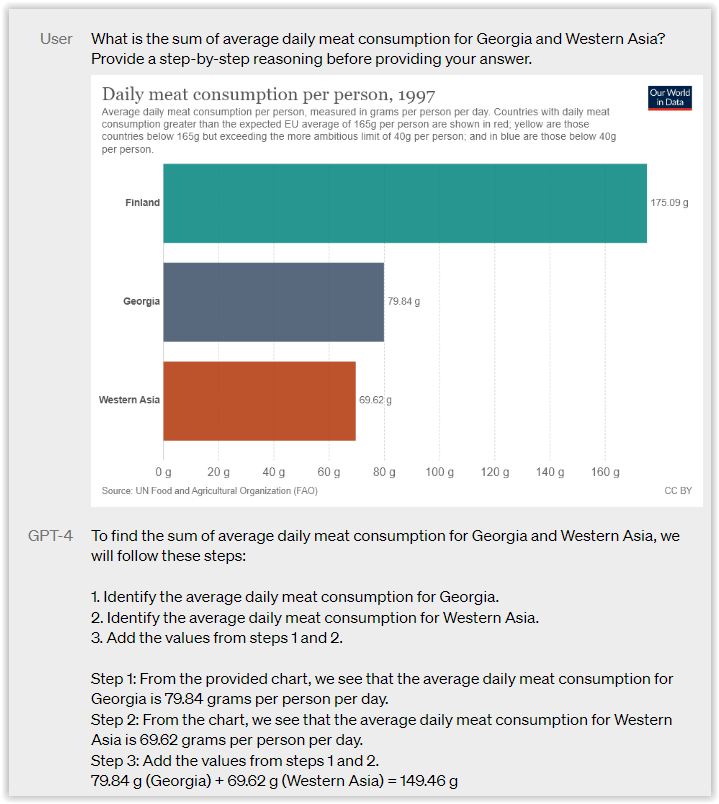 Screenshot from OpenAI, March 2023
Screenshot from OpenAI, March 2023Imagine this technology integrated with Google Analytics or Matomo. You could get highly accurate analytics for all your dashboards in a few minutes.
7. Reduction Of Inappropriate Or Biased Responses
GPT-4 implements mechanisms to minimize undesirable results, thereby increasing reliability and ethical responsibility.
For example, GPT-4 is less likely to generate politically biased, offensive, or harmful content, making it a more trustworthy AI companion than GPT-3.5.
Where Can ChatGPT Go Next?
Despite its remarkable advancements, ChatGPT still has room for improvement:
- Addressing neutrality: Enhancing its ability to discern the context and respond accordingly.
- Understanding the user: Developing the capacity to understand who is communicating (who, where, and how).
- External integrations: Expanding its reach through web, API, and robotic integrations.
- Long-term memory: Improving its ability to recall past interactions and apply that knowledge to future conversations.
- Reducing hallucination: Minimizing instances where the AI is convinced of false information.
As ChatGPT continues to evolve, it is poised to revolutionize marketing and AI-driven communications.
Its potential applications in content creation, education, customer service, and more are vast, making it an essential tool for businesses and individuals in the digital age.
More Resources:
Featured Image: LALAKA/Shutterstock
SEO
Google Further Postpones Third-Party Cookie Deprecation In Chrome

Google has again delayed its plan to phase out third-party cookies in the Chrome web browser. The latest postponement comes after ongoing challenges in reconciling feedback from industry stakeholders and regulators.
The announcement was made in Google and the UK’s Competition and Markets Authority (CMA) joint quarterly report on the Privacy Sandbox initiative, scheduled for release on April 26.
Chrome’s Third-Party Cookie Phaseout Pushed To 2025
Google states it “will not complete third-party cookie deprecation during the second half of Q4” this year as planned.
Instead, the tech giant aims to begin deprecating third-party cookies in Chrome “starting early next year,” assuming an agreement can be reached with the CMA and the UK’s Information Commissioner’s Office (ICO).
The statement reads:
“We recognize that there are ongoing challenges related to reconciling divergent feedback from the industry, regulators and developers, and will continue to engage closely with the entire ecosystem. It’s also critical that the CMA has sufficient time to review all evidence, including results from industry tests, which the CMA has asked market participants to provide by the end of June.”
Continued Engagement With Regulators
Google reiterated its commitment to “engaging closely with the CMA and ICO” throughout the process and hopes to conclude discussions this year.
This marks the third delay to Google’s plan to deprecate third-party cookies, initially aiming for a Q3 2023 phaseout before pushing it back to late 2024.
The postponements reflect the challenges in transitioning away from cross-site user tracking while balancing privacy and advertiser interests.
Transition Period & Impact
In January, Chrome began restricting third-party cookie access for 1% of users globally. This percentage was expected to gradually increase until 100% of users were covered by Q3 2024.
However, the latest delay gives websites and services more time to migrate away from third-party cookie dependencies through Google’s limited “deprecation trials” program.
The trials offer temporary cookie access extensions until December 27, 2024, for non-advertising use cases that can demonstrate direct user impact and functional breakage.
While easing the transition, the trials have strict eligibility rules. Advertising-related services are ineligible, and origins matching known ad-related domains are rejected.
Google states the program aims to address functional issues rather than relieve general data collection inconveniences.
Publisher & Advertiser Implications
The repeated delays highlight the potential disruption for digital publishers and advertisers relying on third-party cookie tracking.
Industry groups have raised concerns that restricting cross-site tracking could push websites toward more opaque privacy-invasive practices.
However, privacy advocates view the phaseout as crucial in preventing covert user profiling across the web.
With the latest postponement, all parties have more time to prepare for the eventual loss of third-party cookies and adopt Google’s proposed Privacy Sandbox APIs as replacements.
Featured Image: Novikov Aleksey/Shutterstock
SEO
How To Write ChatGPT Prompts To Get The Best Results

ChatGPT is a game changer in the field of SEO. This powerful language model can generate human-like content, making it an invaluable tool for SEO professionals.
However, the prompts you provide largely determine the quality of the output.
To unlock the full potential of ChatGPT and create content that resonates with your audience and search engines, writing effective prompts is crucial.
In this comprehensive guide, we’ll explore the art of writing prompts for ChatGPT, covering everything from basic techniques to advanced strategies for layering prompts and generating high-quality, SEO-friendly content.
Writing Prompts For ChatGPT
What Is A ChatGPT Prompt?
A ChatGPT prompt is an instruction or discussion topic a user provides for the ChatGPT AI model to respond to.
The prompt can be a question, statement, or any other stimulus to spark creativity, reflection, or engagement.
Users can use the prompt to generate ideas, share their thoughts, or start a conversation.
ChatGPT prompts are designed to be open-ended and can be customized based on the user’s preferences and interests.
How To Write Prompts For ChatGPT
Start by giving ChatGPT a writing prompt, such as, “Write a short story about a person who discovers they have a superpower.”
ChatGPT will then generate a response based on your prompt. Depending on the prompt’s complexity and the level of detail you requested, the answer may be a few sentences or several paragraphs long.
Use the ChatGPT-generated response as a starting point for your writing. You can take the ideas and concepts presented in the answer and expand upon them, adding your own unique spin to the story.
If you want to generate additional ideas, try asking ChatGPT follow-up questions related to your original prompt.
For example, you could ask, “What challenges might the person face in exploring their newfound superpower?” Or, “How might the person’s relationships with others be affected by their superpower?”
Remember that ChatGPT’s answers are generated by artificial intelligence and may not always be perfect or exactly what you want.
However, they can still be a great source of inspiration and help you start writing.
Must-Have GPTs Assistant
I recommend installing the WebBrowser Assistant created by the OpenAI Team. This tool allows you to add relevant Bing results to your ChatGPT prompts.
This assistant adds the first web results to your ChatGPT prompts for more accurate and up-to-date conversations.
It is very easy to install in only two clicks. (Click on Start Chat.)
For example, if I ask, “Who is Vincent Terrasi?,” ChatGPT has no answer.
With WebBrower Assistant, the assistant creates a new prompt with the first Bing results, and now ChatGPT knows who Vincent Terrasi is.
 Screenshot from ChatGPT, March 2023
Screenshot from ChatGPT, March 2023You can test other GPT assistants available in the GPTs search engine if you want to use Google results.
Master Reverse Prompt Engineering
ChatGPT can be an excellent tool for reverse engineering prompts because it generates natural and engaging responses to any given input.
By analyzing the prompts generated by ChatGPT, it is possible to gain insight into the model’s underlying thought processes and decision-making strategies.
One key benefit of using ChatGPT to reverse engineer prompts is that the model is highly transparent in its decision-making.
This means that the reasoning and logic behind each response can be traced, making it easier to understand how the model arrives at its conclusions.
Once you’ve done this a few times for different types of content, you’ll gain insight into crafting more effective prompts.
Prepare Your ChatGPT For Generating Prompts
First, activate the reverse prompt engineering.
- Type the following prompt: “Enable Reverse Prompt Engineering? By Reverse Prompt Engineering I mean creating a prompt from a given text.”
 Screenshot from ChatGPT, March 2023
Screenshot from ChatGPT, March 2023ChatGPT is now ready to generate your prompt. You can test the product description in a new chatbot session and evaluate the generated prompt.
- Type: “Create a very technical reverse prompt engineering template for a product description about iPhone 11.”
 Screenshot from ChatGPT, March 2023
Screenshot from ChatGPT, March 2023The result is amazing. You can test with a full text that you want to reproduce. Here is an example of a prompt for selling a Kindle on Amazon.
- Type: “Reverse Prompt engineer the following {product), capture the writing style and the length of the text :
product =”
 Screenshot from ChatGPT, March 2023
Screenshot from ChatGPT, March 2023I tested it on an SEJ blog post. Enjoy the analysis – it is excellent.
- Type: “Reverse Prompt engineer the following {text}, capture the tone and writing style of the {text} to include in the prompt :
text = all text coming from https://www.searchenginejournal.com/google-bard-training-data/478941/”
 Screenshot from ChatGPT, March 2023
Screenshot from ChatGPT, March 2023But be careful not to use ChatGPT to generate your texts. It is just a personal assistant.
Go Deeper
Prompts and examples for SEO:
- Keyword research and content ideas prompt: “Provide a list of 20 long-tail keyword ideas related to ‘local SEO strategies’ along with brief content topic descriptions for each keyword.”
- Optimizing content for featured snippets prompt: “Write a 40-50 word paragraph optimized for the query ‘what is the featured snippet in Google search’ that could potentially earn the featured snippet.”
- Creating meta descriptions prompt: “Draft a compelling meta description for the following blog post title: ’10 Technical SEO Factors You Can’t Ignore in 2024′.”
Important Considerations:
- Always Fact-Check: While ChatGPT can be a helpful tool, it’s crucial to remember that it may generate inaccurate or fabricated information. Always verify any facts, statistics, or quotes generated by ChatGPT before incorporating them into your content.
- Maintain Control and Creativity: Use ChatGPT as a tool to assist your writing, not replace it. Don’t rely on it to do your thinking or create content from scratch. Your unique perspective and creativity are essential for producing high-quality, engaging content.
- Iteration is Key: Refine and revise the outputs generated by ChatGPT to ensure they align with your voice, style, and intended message.
Additional Prompts for Rewording and SEO:
– Rewrite this sentence to be more concise and impactful.
– Suggest alternative phrasing for this section to improve clarity.
– Identify opportunities to incorporate relevant internal and external links.
– Analyze the keyword density and suggest improvements for better SEO.
Remember, while ChatGPT can be a valuable tool, it’s essential to use it responsibly and maintain control over your content creation process.
Experiment And Refine Your Prompting Techniques
Writing effective prompts for ChatGPT is an essential skill for any SEO professional who wants to harness the power of AI-generated content.
Hopefully, the insights and examples shared in this article can inspire you and help guide you to crafting stronger prompts that yield high-quality content.
Remember to experiment with layering prompts, iterating on the output, and continually refining your prompting techniques.
This will help you stay ahead of the curve in the ever-changing world of SEO.
More resources:
Featured Image: Tapati Rinchumrus/Shutterstock
SEO
Measuring Content Impact Across The Customer Journey

Understanding the impact of your content at every touchpoint of the customer journey is essential – but that’s easier said than done. From attracting potential leads to nurturing them into loyal customers, there are many touchpoints to look into.
So how do you identify and take advantage of these opportunities for growth?
Watch this on-demand webinar and learn a comprehensive approach for measuring the value of your content initiatives, so you can optimize resource allocation for maximum impact.
You’ll learn:
- Fresh methods for measuring your content’s impact.
- Fascinating insights using first-touch attribution, and how it differs from the usual last-touch perspective.
- Ways to persuade decision-makers to invest in more content by showcasing its value convincingly.
With Bill Franklin and Oliver Tani of DAC Group, we unravel the nuances of attribution modeling, emphasizing the significance of layering first-touch and last-touch attribution within your measurement strategy.
Check out these insights to help you craft compelling content tailored to each stage, using an approach rooted in first-hand experience to ensure your content resonates.
Whether you’re a seasoned marketer or new to content measurement, this webinar promises valuable insights and actionable tactics to elevate your SEO game and optimize your content initiatives for success.
View the slides below or check out the full webinar for all the details.
-

 PPC6 days ago
PPC6 days ago19 Best SEO Tools in 2024 (For Every Use Case)
-

 MARKETING7 days ago
MARKETING7 days agoEcommerce evolution: Blurring the lines between B2B and B2C
-
SEARCHENGINES5 days ago
Daily Search Forum Recap: April 19, 2024
-
SEARCHENGINES6 days ago
Daily Search Forum Recap: April 18, 2024
-

 WORDPRESS6 days ago
WORDPRESS6 days agoHow to Make $5000 of Passive Income Every Month in WordPress
-

 SEO6 days ago
SEO6 days ago2024 WordPress Vulnerability Report Shows Errors Sites Keep Making
-

 WORDPRESS6 days ago
WORDPRESS6 days ago10 Amazing WordPress Design Resouces – WordPress.com News
-
WORDPRESS7 days ago
[GET] The7 Website And Ecommerce Builder For WordPress















